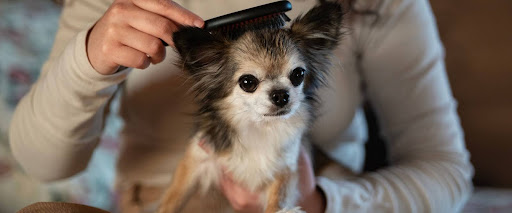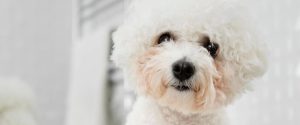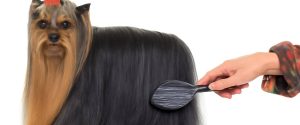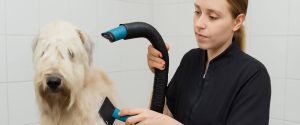Brushing your dog is a critical aspect of their overall health and grooming routine. Many dog owners find themselves wondering, how often should I brush my dog? The answer isn’t one-size-fits-all and depends on your dog’s breed, coat type, and activity level. Whether you have a fluffy Poodle, a sleek Beagle, or a double-coated Golden Retriever, understanding your dog’s grooming needs is crucial for maintaining their comfort, cleanliness, and overall health.
In this guide, we’ll break down everything you need to know about dog brushing frequency, including how often to brush your dog based on their coat type, the benefits of brushing, and tips for incorporating grooming into your routine. If you need professional help with your dog’s grooming, Kontota provides expert mobile dog grooming services tailored to your dog’s needs and ensures your dog looks and feels great!
Why Is Brushing Your Dog Important?

Brushing your dog is much more than just about appearance. It plays an essential role in your dog’s health, comfort, and hygiene. Here’s why it’s so important:
- Prevents Matting and Tangles: Mats and tangles can trap dirt, moisture, and parasites against your dog’s skin, causing discomfort and potential skin issues. Regular brushing prevents this.
- Reduces Shedding: Some breeds shed more than others. Brushing helps to remove loose fur before it lands on your furniture or clothes, reducing the overall amount of shedding around the house.
- Improves Skin Health: Brushing helps distribute natural oils across your dog’s coat, keeping their skin healthy and reducing dryness or irritation.
- Maintains Coat Appearance: Regular brushing ensures your dog’s coat looks shiny, healthy, and well-maintained, reflecting your dog’s overall well-being.
Brushing Dog By Coat Type
When it comes to brushing your dog, the frequency depends heavily on the type of coat different dog breeds have. Some dogs may require frequent grooming to keep their coats looking their best, while others need only occasional brushing. Here are some more details you should know about brushing dog by coat type.
Short-Coated Dogs

For short-coated dogs like Beagles, Bulldogs, and Boxers, brushing requirements are minimal. These dogs typically have fur that lies close to the skin, and it doesn’t mat or tangle easily. However, while their grooming needs are lower, regular brushing is still important to help remove loose hair, dirt, and debris from their coats. This simple brushing routine helps to keep their fur smooth and glossy while also reducing shedding around the home. Brushing once a week is usually sufficient to keep their coat in good shape and maintain cleanliness.
Pro Tip: A rubber brush or bristle brush works well to remove loose fur and ensure that your dog’s coat stays healthy.
Long-Coated Dogs

When it comes to long-coated dogs like Shih Tzus, Collies, and Afghan Hounds, more frequent grooming is necessary. These breeds have coats that grow long. Without regular care, their fur can easily become tangled or matted, which can be painful and uncomfortable for your dog. Brushing every 2 to 3 days is ideal for these dogs. Regular brushing helps to keep their long coats tangle-free and reduces the risk of mats forming, which could irritate their skin. Long-haired dogs often require professional grooming sessions as well to maintain their coats’ length and health.
Pro Tip: A slicker brush or comb is effective for reaching through the longer fur and detangling any knots.
Curly-Coated Dogs

Curly-coated dogs, such as Poodles, Bichon Frises, and Irish Water Spaniels, have a different set of grooming needs. Their curly hair grows continuously, and without regular brushing, it can quickly become matted. Although these dogs don’t shed as much as other breeds, their dense, curly coats require attention to maintain their appearance. Brushing curly-coated dogs every 2-3 days is important to prevent tangling, matting, and dirt buildup. You’ll need to use a detangling spray or conditioner to help remove any knots.
Pro Tip: It’s also a good idea to schedule regular professional grooming to keep their curls neat and well-shaped. With consistent brushing, your curly-coated dog will have a comfortable and tangle-free coat.
Double-Coated Dogs

Double-coated dogs, such as Golden Retrievers, Huskies, and German Shepherds, have two layers of fur: a soft, dense undercoat and a coarser outer coat. This combination makes them more prone to shedding, especially during seasonal changes. Their undercoat sheds heavily in the spring and fall, and without proper grooming, the shedding can lead to mats and discomfort. To keep these dogs comfortable and maintain a healthy coat, brushing 2-3 times per week is essential. During shedding seasons, more frequent brushing is needed to manage the heavy hair loss and to remove loose fur from the undercoat.
Pro Tip: Regular grooming during these peak shedding periods will also reduce shedding and the amount of fur scattered around your home.
Wire-Coated Dogs

For wire-coated dogs like Schnauzers, West Highland Terriers, and Fox Terriers, regular brushing is essential to maintain their distinct wiry coats. These dogs don’t shed much, but their coarse hair needs to be stripped regularly to keep the texture intact and to prevent it from becoming too soft or matted. While brushing once a week is typically enough for routine maintenance, these breeds also benefit from hand-stripping, a grooming technique that removes dead hair manually to keep the coat looking its best. Hand-stripping or professional grooming every 6-8 weeks ensures the wiry coat stays true to its texture and prevents it from becoming tangled or overly soft.
Pro Tip: Specialized tools, such as stripping knives or coarse brushes, are often used to manage this unique coat type.
Benefits of Brushing Dogs Regularly

The importance of brushing your dog cannot be overstated. Apart from maintaining a healthy and shiny coat, you can get several benefits of brushing dogs regularly.
- Reduces Hairballs: Especially in long-haired breeds, brushing helps remove hair that would otherwise be ingested and lead to hairballs.
- Prevents Skin Problems: Regular brushing removes dirt and debris, preventing skin irritation or infections caused by trapped particles, fleas, ticks, or excessive moisture.
- Promotes Circulation: Brushing stimulates blood flow to the skin, encouraging healthy hair growth and overall skin health.
- Strengthens the Bond with Your Dog: Brushing is a bonding activity that allows you to spend quality time with your dog, making them more comfortable during grooming sessions.
How to Brush Your Dog Properly

Brushing your dog isn’t just about getting rid of loose hair; it’s about doing it in a way that’s gentle and effective. Here are some tips:
- Choose the Right Brush: Use a brush appropriate for your dog’s coat type. Slicker brushes work well for long-haired and curly-coated dogs, while bristle brushes are suitable for short-haired breeds.
- Brush in the Right Direction: Always brush in the direction of hair growth. Be gentle, especially around sensitive areas like the belly and face.
- Start at the Skin: Work your way from the skin to the tips of the fur, gently parting tangles as you go. For dogs with thick coats, using a detangling spray can help ease through mats.
- Make It a Routine: Dogs thrive on routines, so try to brush them at the same time each day or week. Consistency is key to effective grooming.
Kontota Professional Grooming Services: Why You Should Consider Them
Sometimes, brushing and grooming can be too much for dog owners, especially for those with busy schedules or dogs with difficult coats. This is where professional dog grooming services come in.
At Kontota, expert groomers understand the specific grooming needs of different dog breeds and coat types. They offer a range of mobile grooming services that cater to your dog’s needs, ensuring that they receive the best care and grooming experience by utilizing pet-safe products.
If you’re unsure how often to brush your dog or need help with complicated grooming tasks like dematting or trimming, contacting professionals is always a good choice. Kontota’s team provides personalized grooming plans to suit your dog’s lifestyle, ensuring they remain happy, healthy, and comfortable.
Conclusion: Keep Your Dog’s Coat Shiny with Proper Dog Brushing Frequency
Regular brushing is essential for maintaining your dog’s health and appearance. Whether you are dealing with a long-haired breed or a short-coated pup, recommended dog brushing frequency not only ensures a shiny and beautiful coat but also contributes to your dog’s overall health and happiness.
If you need assistance with brushing or grooming, Kontota’s professional mobile grooming services can help. They specialize in all coat types and offer convenient, expert care for your furry friend. Visit Kontota today and schedule a grooming session to keep your dog looking their best!
By understanding your dog’s brushing needs and incorporating it into your routine, you’re ensuring they lead a healthier, more comfortable life.
FAQs – How Often Should You Brush Your Dog
How often should I brush my dog?
It depends on your dog’s coat type. Short-haired dogs should be brushed once a week, while long-haired and curly-coated dogs may need brushing 2-3 times a week.
Can I brush my dog every day?
Yes, especially if your dog has a long or thick coat. Daily brushing can help prevent matting and ensure their coat stays healthy.
What if my dog doesn’t like brushing?
Be patient and start slow. Use positive reinforcement, such as treats or affection, to help your dog associate brushing with a pleasant experience.
Can brushing my dog reduce shedding?
While it can’t stop shedding entirely, brushing regularly helps remove loose fur and minimizes the amount of hair shed in your home.
Should I take my dog to a groomer for brushing?
While you can brush your dog at home, professional groomers can handle more complicated grooming needs, such as trimming, detangling, or managing thick undercoats.



